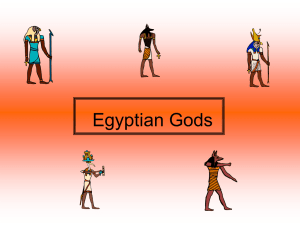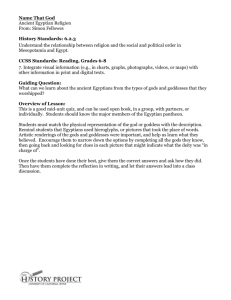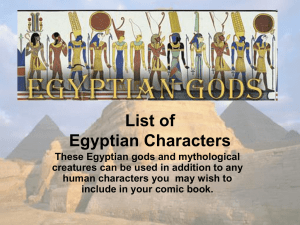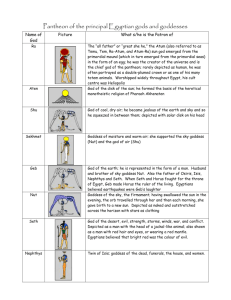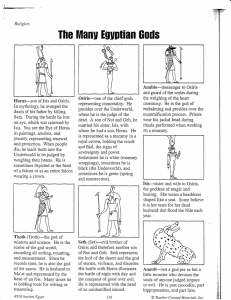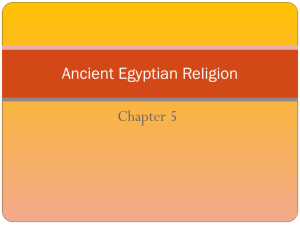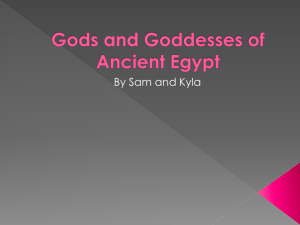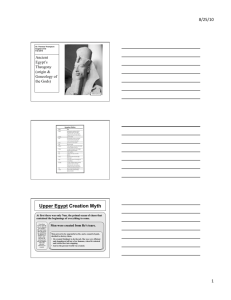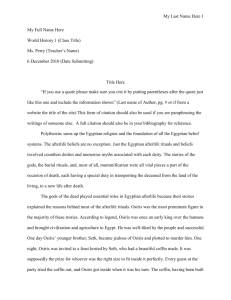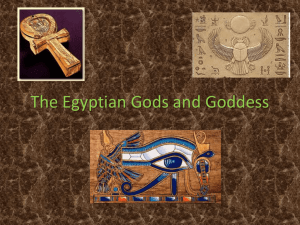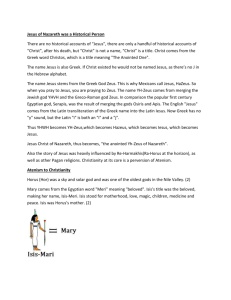Egyptian gods/goddesses
advertisement
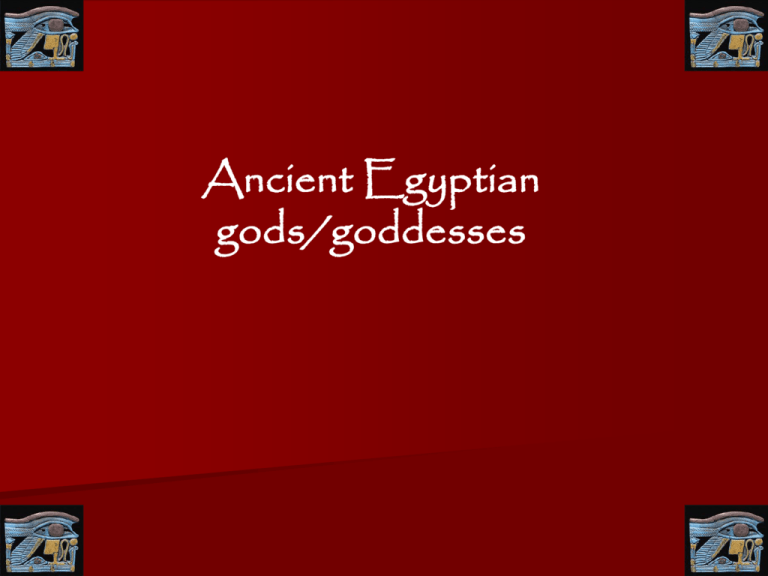
Ancient Egyptian gods/goddesses Ra (Re) 'Sun' Appearance: •Man w) hawk head & headdress w) sun disk Sun god. Most important god of ancient Egyptians. Ra (Re) was swallowed every night by the sky goddess Nut, & reborn every morning. Traveled through the underworld at night. In the underworld, Ra (Re) appeared as a man with the head of a ram. Amun Appearance: •Man with a ram-head •Man wearing an ostrich plumed hat One of most powerful gods in ancient Egypt. At height of Egyptian civilization he was called the 'King of the Gods'. Important throughout Egyptian history. When Amun was combined with the sun god Ra(Re) he was even more powerful. Amun-Ra. A large and important temple was built at Thebes to honor Amun. Anubis Appearance: •Man with a jackal head •A jackal god of embalming and the dead Since jackals were often seen in cemeteries, the ancient Egyptians believed that Anubis watched over the dead. Helped to embalm Osiris after he was killed by Seth. Watched over the process of mummifying people when they died. Priests often wore a mask of Anubis during mummification ceremonies. Hapy Appearance: •Man with a pot belly, shown with water plants god of the innundation. Especially important ancient Egyptians because he brought the flood every year. Flood deposited rich silt on the banks of the Nile, allowing the Egyptians to grow crops. Isis Appearance: •Woman w) headdress in the shape of a throne •A pair of cow horns with a sun disk Protective goddess. She used powerful magic spells to help people in need Isis was wife of Osiris and the mother of Horus. Since each pharaoh was considered the 'living Horus', Isis was very important. Isis is often shown holding Horus on her lap. Isis is associated with thrones because her lap was the first 'throne' that Horus sat upon. This amulet is called the 'Isis knot' and is a symbol of protection. Horus “The One Far Above” Appearance: •Man with the head of a hawk •A hawk god of the Sky Most well-known as protector of the ruler of Egypt. Egyptians believed pharaoh was the 'living Horus'. Many different beliefs about Horus. Common belief: Horus was son of Isis & Osiris. After Osiris was murdered by his brother Seth, Horus fought with Seth for the throne of Egypt. In this battle, Horus lost one of his eyes. The eye was restored to him and it became a symbol of protection for the ancient Egyptians. After this battle, Horus was chosen to be the ruler of the world of the living. Ma'at Appearance: •Woman with a feather on her head •A feather goddess of truth, justice & harmony Associated with the balance of things on earth. Ma'at was the daughter of the sun god Ra (Re). Pharaohs frequently shown in wall reliefs making offering of Ma'at to the gods-showing that they are preserving harmony & justice on earth. The vizier--in charge of the law courts--was known as the 'priest of Ma'at'. Ma'at: Weighing of the Heart Ancient Egyptians believed the heart recorded all of the good and bad deeds of a person's life, and was needed for judgment in the afterlife. After a person died, heart was weighed against the feather of Ma’at (goddess of truth and justice). The scales were watched by Anubis (the jackalheaded god of embalming) and the results recorded by Thoth (the ibis-headed god of writing). If a person had led a decent life, the heart balanced with the feather and the person was rendered worthy to live forever in paradise with Osiris. Osiris Appearance: •A mummified man wearing a white conelike headdress with feathers god of the dead & ruler of the underworld Brother/husband of Isis, and the brother of Nepthys and Seth. He was also the father of Horus. As well as being a god of the dead, Osiris was a god of resurrection and fertility. In fact, the ancient Egyptians believed that Osiris gave them the gift of barley, one of their most important crops. Seth Appearance: •Man with the head of a 'Seth animal' (unidentifiable) god of chaos Represented everything that threatened harmony in Egypt. Brother of Osiris and Isis, as well as the brother/husband of Nepthys. He murdered his brother Osiris, then battled with his nephew Horus to be the ruler of the living. At times in Egypt, Seth associated w) royalty. Bes Appearance: •Dwarf with lion and human features •Dwarf wearing the skin of a lion Protector of pregnant women, newborn babies & the family. Believed that Bes protected against snake & scorpion bites. Amulets of Bes were popular at all levels of Egyptian society. Nut Appearance: •Woman whose body arches across the sky, wearing a dress decorated with stars. Sky-goddess--body created a vault or canopy over the earth. Sister/wife of Geb, the god of the earth. Also mother of Isis, Osiris, Nepthys & Seth. Believed that at the end of the day, Nut swallowed the sun-god, Ra(Re), & gave birth to him again the next morning. Geb Appearance: •Man lying down below arch of the sky goddess Nut •Man with a goose on his head god of the Earth – husband/brother of the sky goddess Nut. Also father of Osiris, Isis, Nepthys and Seth. When Seth and Horus fought for the throne of Egypt, Geb made Horus the ruler of the living. Believed that earthquakes were Geb's laughter. Shu 'He Who Rises Up' Appearance: •Man wearing headdress w) feathers •A lion god of the Air Shu held up the figure of Nut so that the earth and the sky were separated. Aten Appearance: •A sun disk with rays which end in hands A form of the sun god Ra (Re) During reign of Akhenaten, the Aten was made the 'king' of the gods.
